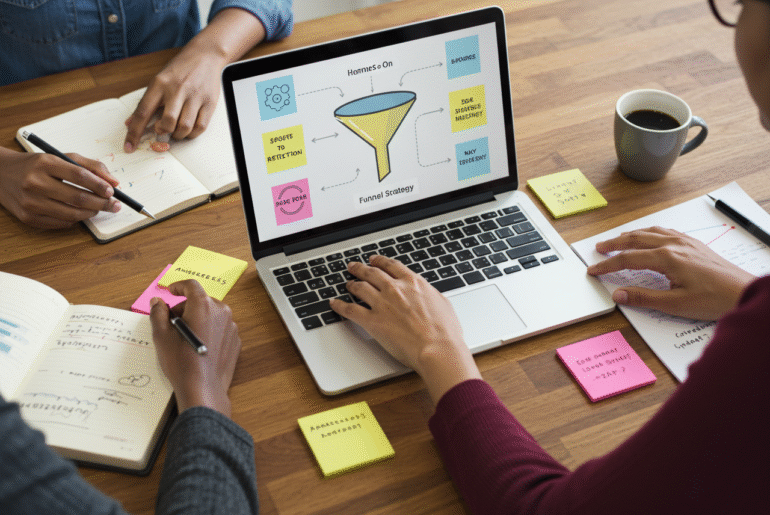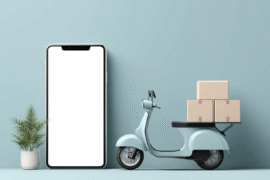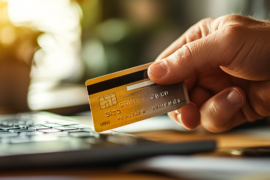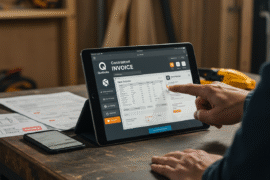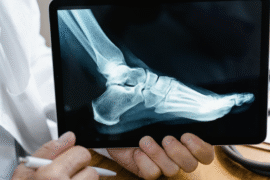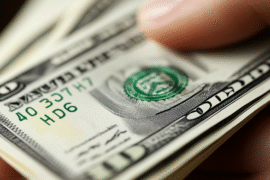This article may contain references to products or services from one or more of our advertisers or partners. We may receive compensation when you click on links to those products or services. Nonetheless, our opinions are our own.
The information presented in this article is accurate to the best of our knowledge at the time of publication. However, information is subject to change, and no guarantees are made about the continued accuracy or completeness of this content after its publication date.
- Introduction
- What a Marketing Funnel Does in Digital Marketing
- Why Marketing Funnels Help Grow a Business
- How Funnels Work Across Each Stage
- The Five Stages of the Marketing Funnel
- Popular Funnels for Digital Marketing Goals
- How to Build Your First Funnel as a Beginner
- Takeaways from Building a Funnel
- Your Questions Answered
- Recommended Reads
Introduction
The marketing funnel has become a cornerstone of digital strategy, helping businesses move potential customers from awareness to repeat purchases. This structure supports better planning, higher conversions, and smarter communication with audiences.
What a Marketing Funnel Does in Digital Marketing
A marketing funnel outlines the path a person takes from learning about your brand to becoming a paying customer. It simplifies the customer journey and helps businesses tailor their approach at each step.
How the Funnel Framework Guides the Customer Path
Funnels act as roadmaps, helping guide users through awareness, interest, consideration, and action. Each stage is designed to deliver the right message to the right person at the right time, improving engagement and increasing sales.
What Defines a Marketing Funnel
A marketing funnel is defined by its structured approach to converting leads into customers. It breaks the customer journey into stages and aligns marketing efforts accordingly, whether through social media, email, or content marketing.
Why Marketing Funnels Help Grow a Business
Marketing funnels help streamline lead generation, increase conversion rates, and build lasting customer relationships. They allow businesses to track performance and scale outreach more effectively.
How Funnels Work Across Each Stage
Each stage of the funnel supports a different goal: raising awareness, nurturing interest, prompting consideration, and closing sales. Funnels also extend beyond the sale by encouraging loyalty and repeat engagement.
The Path from Prospect to Customer
The journey begins with attracting attention through ads or organic content. As trust builds, prospects engage with educational content and gradually become ready to take action, such as making a purchase or subscribing.
Features That Make Funnels Perform Better
Effective funnels include well-designed landing pages, valuable lead magnets, strong calls to action, and social proof. These features increase conversions and reinforce brand credibility.
Voted "Best Overall Budgeting App" by Forbes and WSJ
Monarch Money helps you budget, track spending, set goals, and plan your financial future—all in one app.
Get 50% OFF your first year with code MONARCHVIP
The Five Stages of the Marketing Funnel
The five key stages are Awareness, Interest, Consideration, Conversion, and Retention. Each stage represents a critical phase in the customer decision-making process.
Awareness Stage: Gaining Initial Interest
This is where potential customers first discover your brand through content marketing, ads, or search engines. The goal is to spark curiosity and encourage further interaction.
Interest Stage: Deepening Customer Engagement
At this stage, users are aware of your brand and are evaluating whether it aligns with their needs. Providing value through blog posts, free resources, or webinars helps maintain interest.
Consideration Stage: Earning Trust
Customers begin comparing options and seeking reassurance. Case studies, testimonials, and clear product benefits can make your offer stand out.
Conversion Stage: Motivating a Final Decision
When ready to act, users respond best to clear calls to action, optimized landing pages, and limited-time offers. This stage should eliminate friction and reinforce confidence.
Retention Stage: Keeping Customers Loyal
Post-purchase engagement is vital for long-term success. Retention strategies include follow-up emails, loyalty programs, and personalized content to maintain connection.
Popular Funnels for Digital Marketing Goals
Different types of funnels are suited for specific goals such as growing email lists, launching products, or increasing online sales. Each type plays a unique role in your marketing strategy.
Lead Generation Funnels
Lead generation funnels aim to capture user information in exchange for valuable resources. These are ideal for building email lists and initiating customer relationships.
Webinar and Event Funnels
These funnels promote live or recorded sessions to build engagement and educate potential buyers. They’re useful for high-ticket services and niche markets.
Product Launch Funnels
Used during new product releases, these funnels create buzz and drive immediate interest through pre-launch content, timed offers, and compelling storytelling.
E-commerce Funnels
Designed for online stores, e-commerce funnels streamline the path from product discovery to purchase. Abandoned cart emails and upsells can help increase order value.
How to Build Your First Funnel as a Beginner
Starting with a funnel requires the right tools, clear messaging, and a focus on user behavior. Understanding your audience’s needs is key to building a funnel that converts.
What Tools and Resources Are Needed
You’ll need tools like email marketing platforms (e.g., Mailchimp), CRM systems (e.g., HubSpot), analytics tools (e.g., Google Analytics), and landing page builders (e.g., Unbounce).
Mistakes to Avoid While Building Funnels
Common mistakes include targeting the wrong audience, failing to test performance, and using generic messaging. Avoid skipping analytics and neglecting mobile optimization.
Steps for Setting Up a Funnel That Works
Step 1: Target Audience and Clear Goals
Define who your funnel is for and what outcomes you want: more leads, more purchases, or more engagement. Start with basic audience segmentation and set performance goals.
Step 2: Content That Matches Funnel Stages
Top-of-funnel content should be educational. Middle-of-funnel assets should address pain points. Bottom-of-funnel content should encourage conversions through strong CTAs.
Step 3: Tracking Tools and Performance Metrics
Set up analytics to track conversions, bounce rates, and lead quality. These insights allow you to adjust your funnel based on real user behavior.
Step 4: A/B Testing and Funnel Improvements
Test different versions of landing pages, headlines, and CTAs. Use results to refine the funnel continuously, optimizing for better outcomes over time.
Takeaways from Building a Funnel
Marketing funnels work best when structured around the user journey. Using clear messaging, testing performance, and nurturing leads can help drive growth. Over time, a well-built funnel turns prospects into long-term customers.
Your Questions Answered
What are the benefits of using a marketing funnel?
Funnels simplify the customer journey, help personalize outreach, and improve marketing ROI. They also boost lead quality and conversion rates.
How do I choose the right funnel type?
Select a funnel based on your business goals: lead generation, product sales, or brand awareness. Consider available resources and timelines when choosing.
What tools can help me build my first funnel?
Popular tools include HubSpot (CRM), Mailchimp (email automation), Unbounce (landing pages), and Google Analytics (performance tracking).
How do I measure funnel success?
Use metrics like conversion rate, customer acquisition cost, and lead quality. Regularly analyze data to improve weak stages in the funnel.

Reviewed and edited by Albert Fang.
See a typo or want to suggest an edit/revision to the content? Use the contact us form to provide feedback.
At FangWallet, we value editorial integrity and open collaboration in curating quality content for readers to enjoy. Much appreciated for the assist.
Did you like our article and find it insightful? We encourage sharing the article link with family and friends to benefit as well - better yet, sharing on social media. Thank you for the support! 🍉
Article Title: How Marketing Funnels Work in Digital Strategy
https://fangwallet.com/2025/07/15/how-marketing-funnels-work-in-digital-strategy/The FangWallet Promise
FangWallet is an editorially independent resource - founded on breaking down challenging financial concepts for anyone to understand since 2014. While we adhere to editorial integrity, note that this post may contain references to products from our partners.
The FangWallet promise is always to have your best interest in mind and be transparent and honest about the financial picture.
Become an Insider

Subscribe to get a free daily budget planner printable to help get your money on track!
Make passive money the right way. No spam.
Editorial Disclaimer: The editorial content on this page is not provided by any of the companies mentioned. The opinions expressed here are the author's alone.
The content of this website is for informational purposes only and does not represent investment advice, or an offer or solicitation to buy or sell any security, investment, or product. Investors are encouraged to do their own due diligence, and, if necessary, consult professional advising before making any investment decisions. Investing involves a high degree of risk, and financial losses may occur including the potential loss of principal.
Source Citation References:
+ Inspo
There are no additional citations or references to note for this article at this time.
